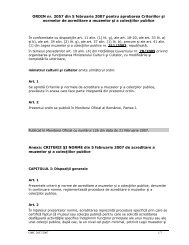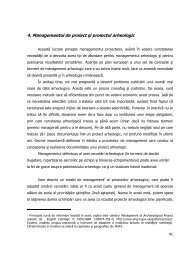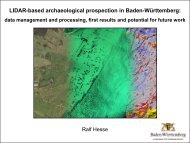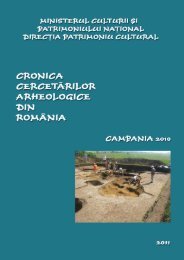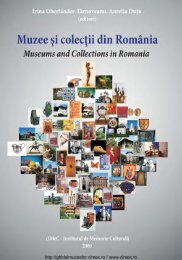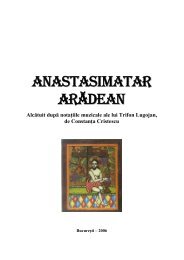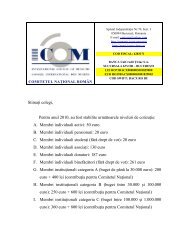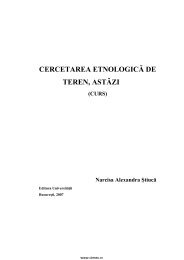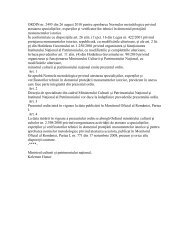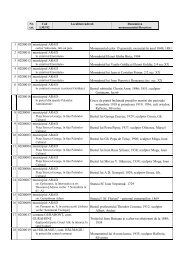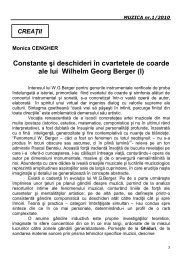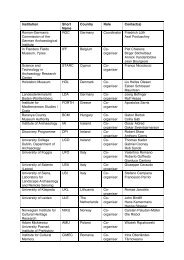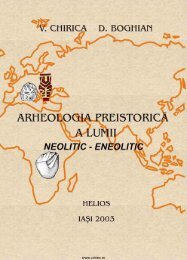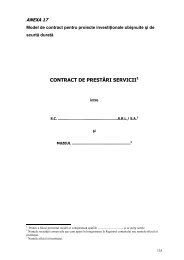pdf (15 MB) - cIMeC
pdf (15 MB) - cIMeC
pdf (15 MB) - cIMeC
You also want an ePaper? Increase the reach of your titles
YUMPU automatically turns print PDFs into web optimized ePapers that Google loves.
Cronica cercetărilor arheologice din România – campania 2006<br />
urmărit identificarea incluziunilor minerale şi a porozităţii<br />
fragmentelor ceramice. Au fost alese probe din toate<br />
categoriile ceramice reprezentative: grosieră, lustruită (inclusiv<br />
lustruită, de culoare neagră) şi cu slip roşu. S-a observat că<br />
mineralul dominant este cuarţul, în diferite varietăţi<br />
transparente şi opace. Pe lângă acesta, au mai fost identificate<br />
în cantităţi reduse alte minerale precum: feldspat, silturi<br />
feruginoase, silturi calcaroase, pyroxenă. Din punct de vedere<br />
al structurii şi tehnologiei de fabricare ceramica atribuită<br />
acestui orizont timpuriu corespunde ceramicii Starčevo-Criş<br />
analizată în campaniile anterioare.<br />
Bibliografie:<br />
R. Andreescu, D.W. Bailey, Măgura. Raport preliminar, CCA<br />
2005, p. 225-234.<br />
A. van As, L. Jacobs, L. Thissen, Preliminary Data on<br />
Starčevo-Criş and Dudeşti Pottery from TELEOR 003,<br />
Teleorman River Valley, Southern Romania, Leiden Journal of<br />
Archaeological Ceramic Studies 20, 2004, p.121-127.<br />
N. Elenski, Cultural Contacts of North-Central Bulgaria with<br />
Thrace and the Marmara Area in the Early Neolithic, în V.<br />
Nikolov, K. Băčvarov şi P. Kalcev (ed.), Prehistoric Thrace,<br />
Sofia-Stara Zagora, 2004, p. 71-79.<br />
M. Nica, Le groupe culturel Cârcea-Grădinile dans le contexte<br />
du Néolitique balkanique, Zbornik Narodnog Muzeja, Beograd,<br />
14, 1, 1991, pag. 103-112.<br />
Abstract:<br />
The objectives of the 2006 campaign were: the research of<br />
the Neolithic habitation specific in the Eastern side of the<br />
settlement.<br />
For the first time in Walachia, this campaign researches<br />
lead to the identification of a Neolithic habitation belonging to<br />
the earliest Neolithic. This early horizon has analogies in<br />
Oltenia - West of Olt River, as well as South of the Danube,<br />
especially in the basins of Iantra and Rusenski Lom Rivers.<br />
There were discovered three early Neolithic complexes,<br />
two pits and dwellings and 13 modern pits, from which mostly<br />
were store pits (nos. 5 - 17).<br />
The lithic assemblage is represented by flint stones, like<br />
blades, blade fragments, some having lustrum traces (sickle<br />
blades), scarpers, as well as debris. Obsidian was also found<br />
at the site, represented by 3 pieces of black opaque obsidian,<br />
2 blades and a chip.<br />
Bone tools are represented by diggers and spatulas.<br />
Between the special finds there are a needle with a disc shape<br />
head and a perforated herbivore incisive, used as a pendant.<br />
The ceramics: the closed shapes are represented by<br />
spherical pots, very pronounced in the lower part, with<br />
rectangular or round bottom and of small or medium sizes.<br />
Store pots are also present, of large dimensions. The ceramics<br />
is of good quality, polished, generally monochrome, with<br />
different red, orange and brown nuances. The opened shapes<br />
are represented by bowls with straight alveolar lip. The<br />
ceramics has rough exterior surface but well polished interior.<br />
The decoration can be traced rarely. It is realized by plastic<br />
applications, vertically perforated buttons, alveolar girdles and<br />
prominences. Sometimes appears the incised decoration (wide<br />
deep incisions, laterally disposed) as well as the „pinched”<br />
decoration. The white painting is presented at a very small<br />
amount (about 1%) and it is realized on a red background. As<br />
decorative motives there are parallel lines, lines disposed in<br />
networks or zigzag, semicircles and points.<br />
The ceramics is also represented by a series of round<br />
shapes perforated or imperforated and several objects made of<br />
burned clay, of ovoid or discoid shape, with different diameters<br />
and partially or totally perforated. A „labret” (or zoomorphic<br />
amulet) and a clay needle are specific markers for the early<br />
horizon. Several fragments of 4 legged “altars” were also<br />
discovered, some decorated by excision and white paste filled<br />
or by incised lines and points.<br />
The anthropomorphic plastic is illustrated by some<br />
figurines fragments. An anthropomorphic head has an oval<br />
shape, with nose represented by a median prominence and the<br />
chin by a conical one. The zoomorphic plastic is also<br />
represented by some pieces, like a bovine almost entirely<br />
preserved, a bovine head of large size and an ovine head, very<br />
realistic modelled.<br />
An interesting discovery is represented by a wood bowl<br />
fragment, considering the material that it is made of.<br />
118. Mălăieştii de Jos, com. Dumbrăveşti, jud.<br />
Prahova<br />
Punct: La Mornel<br />
Cod sit: 131498.01<br />
Autorizaţia de cercetare arheologică sistematică nr.<br />
51/2006<br />
Colectiv: Radian-Romus Andreescu - responsabil<br />
(MNIR), Alin Frînculeasa, Eugen Paveleţ (MJIA<br />
Prahova), Ion Torcică, Tiberiu Nica<br />
Situl se află amplasat pe terasa dreaptă a Vărbilăului, la<br />
limita de N a localităţii Mălăieştii de Jos. Situl a fost semnalat la<br />
începutul anilor ‘80 de către E. Comşa şi V. Georgescu.<br />
Materialul recuperat prin cercetări de suprafaţă a fost încadrat<br />
aspectului cultural Stoicani-Aldeni, epoca eneolitică. În anul<br />
2002 MJIA Prahova în colaborare cu MNIR au iniţiat cercetări<br />
sistematice în acest punct de interes arheologic, în cadrul unui<br />
proiect ce vizează abordarea ariei nordice a culturii Gumelniţa<br />
şi în general a locuirii neo-eneolitice în zonă.<br />
Obiectivele campaniei 2006 au fost: cercetarea sistematică<br />
a locuinţelor în suprafaţă, a zonelor exterioare acestora, atât<br />
pentru determinarea tipului şi a modului de construcţie, cât şi a<br />
evoluţiei interne a aşezării; deschiderea unor noi suprafeţe<br />
pentru observaţii specifice privind planul şi evoluţia internă ale<br />
aşezării; cercetări de teren în apropierea sitului pentru<br />
descoperirea altor situri, în vederea obţinerii unor observaţii<br />
privind dinamica locuirii în preistorie pe valea râului Vărbilău.<br />
Au fost trasate şi cercetate (integral sau parţial) cinci noi<br />
sectoare denumite convenţional St. 9, St. 10, St. 11, St. 12, St.<br />
13, două secţiuni denumite convenţional S.V şi S.VI, dar şi o<br />
casetă C. De asemenea au continuat cercetările în sectorul 6<br />
nefinalizat în campania precedentă şi caseta B. Secţiunile V şi<br />
VI au fost trasate în cadrul sitului în zone periferice, acolo unde<br />
topografia terenului pare să marcheze limitele de N, respectiv<br />
E ale aşezării. Remarcăm că în aceste zone terenul descrie<br />
pante de 20-25° spre N, respectiv E. Secţiunea V orientată N-<br />
S are 13 x 1,5 m. Secţiunea VI orientată V-E are 9 x 1 m.<br />
Sectorul 9 a fost trasat la 0,5 m E de St. 7/2005, şi la 0,5 m E<br />
de St. 6/2005. Are dimensiuni de 6 x 6 m. Sectoarele 10 şi 11<br />
228




